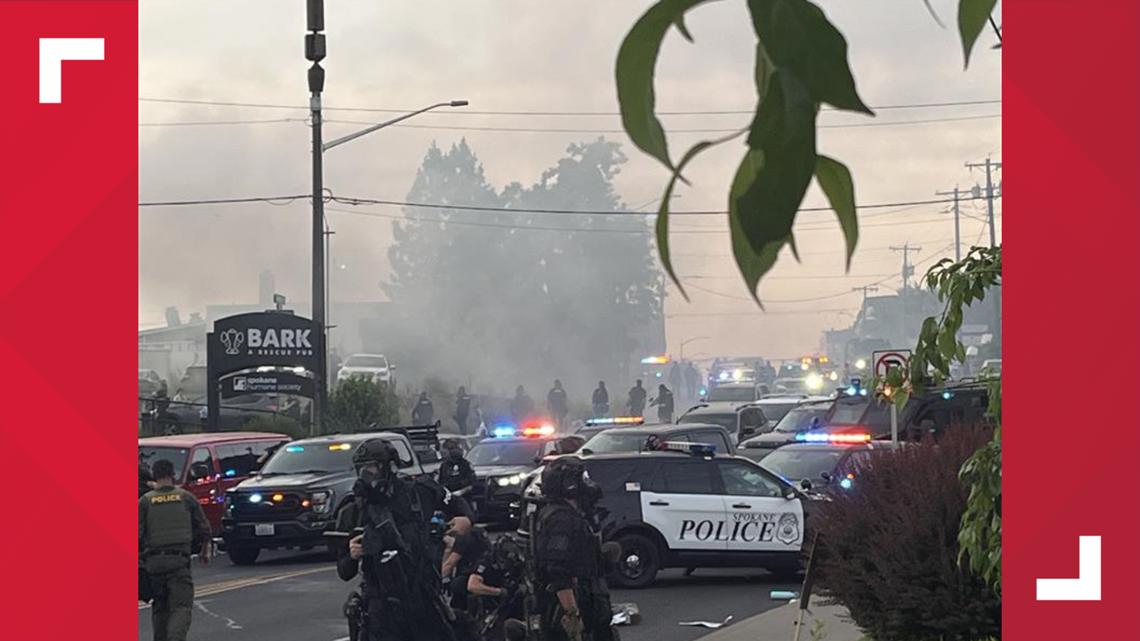A wave of protests has swept through downtown Spokane following the detainment of a 21-year-old Venezuelan asylum seeker by ICE (Immigration and Customs Enforcement). The incident has sparked widespread community outrage, leading to a significant gathering outside the Spokane ICE office. Former Spokane City Councilman Ben Stuckart, now the legal guardian of the detainee, ignited the call to action. In response to escalating tensions, Spokane Mayor Lisa Brown declared a state of emergency, implementing a curfew to maintain public order. This article delves into the unfolding events, exploring the perspectives of protesters, the official response, and the broader implications for immigration policies in Spokane.
Detainment of Asylum Seeker Sparks Outcry
The catalyst for the protests was the detainment of a 21-year-old Venezuelan man seeking asylum. Ben Stuckart, who became the man’s legal guardian three weeks prior, reported that the individual was detained during a routine check-in at the ICE office. According to Stuckart’s Facebook post, both the asylum seeker and a friend were taken into custody, prompting immediate concerns about their safety and legal status. This action ignited a sense of urgency among community members, who quickly mobilized to voice their opposition.
Stuckart’s call to action resonated deeply with local activists and concerned citizens. His Facebook post served as a virtual rallying point, urging supporters to gather at the ICE office to demand the release of the detained asylum seeker. The post quickly gained traction, spreading through social media channels and galvanizing a diverse group of individuals to converge in downtown Spokane.
Protesters Block ICE Transport, Demand Release
As the protest gained momentum, participants took direct action to impede the potential transfer of the detainees. A group of protesters strategically blocked the path of a truck believed to be transporting the men to an ICE processing facility in Tacoma. By positioning vehicles both in front and behind the truck, they effectively created a human barricade, preventing its movement. This act of civil disobedience underscored the protesters’ determination to halt the deportation process and secure the release of the asylum seeker.
One protester passionately articulated their motivation, stating, “It’s immoral, what’s happening right now in our society. I just thought I’d sit in front of the bus and make sure that I can do everything I possibly can to not let my friend leave.” This sentiment encapsulates the moral imperative driving many of the protesters, who view the detainment as an unjust and inhumane act.
Police Response and Escalation Tactics
The Spokane Police Department (SPD) and the Spokane County Sheriff’s Office responded to the growing protest, declaring the gathering unlawful. At approximately 7:45 p.m., authorities announced that protesters would face arrest if they failed to disperse, warning that force, including chemical weapons, might be employed. The situation escalated when police deployed gas on the crowd, leading to further unrest and arrests, including that of Ben Stuckart.
The use of gas by law enforcement drew criticism from protesters and human rights advocates, who condemned the tactic as an excessive and disproportionate response to peaceful assembly. Video footage of the incident quickly circulated on social media, sparking further debate about the appropriate boundaries of police intervention in protest situations. The SPD defended its actions, citing concerns about public safety and the need to maintain order in the face of escalating tensions.
Mayor Declares State of Emergency, Imposes Curfew
In response to the escalating situation, Spokane Mayor Lisa Brown declared a state of emergency and implemented a curfew to begin at 9:30 p.m. The curfew zone encompassed a significant portion of downtown Spokane, stretching from Boone Avenue to Spokane Falls Boulevard and from Howard Street to Division Street, as well as Riverfront Park. The city outlined several exceptions to the curfew, including law enforcement, emergency personnel, media representatives, individuals leaving a soccer game at the Podium, residents living within the curfew area, and those traveling to and from work.
Mayor Brown’s decision to impose a curfew was met with mixed reactions. Supporters argued that it was a necessary measure to restore order and prevent further violence, while critics contended that it infringed upon the rights of peaceful protesters and unfairly targeted the broader community. The curfew announcement added another layer of complexity to an already tense situation, raising questions about the balance between public safety and civil liberties.
Official Statements and Community Impact
Mayor Lisa Brown released a formal statement addressing the unfolding events, emphasizing the city’s commitment to upholding First Amendment rights while also enforcing municipal codes. She stated, “The City of Spokane respects and upholds everyone’s First Amendment rights and right to be on public property. The Spokane Police Department will address violations of Spokane Municipal Code.” Brown also expressed support for the Keep Washington Working Act and conveyed sympathy for families affected by separation, urging unity and peace.
The events surrounding the ICE protest have had a profound impact on the Spokane community, exposing deep divisions and igniting passionate debates about immigration policy, law enforcement tactics, and the role of local government in protecting vulnerable populations. The protests have galvanized activists, drawn attention to the plight of asylum seekers, and prompted renewed scrutiny of ICE practices in the region. As the situation continues to unfold, the long-term consequences for Spokane’s social and political landscape remain uncertain.
Conclusion: A City Divided, A Community Seeking Answers
The protests in Spokane over the detainment of a Venezuelan asylum seeker underscore the complex and often contentious nature of immigration issues in the United States. The events highlight the tensions between federal immigration policies and local values, raising questions about the treatment of asylum seekers and the role of law enforcement in managing protests. As Spokane grapples with the aftermath of these events, the community faces the challenge of bridging divides, fostering dialogue, and seeking solutions that uphold both public safety and human rights. The story continues to develop, and FYM News will provide ongoing coverage and updates.

Leave a Reply